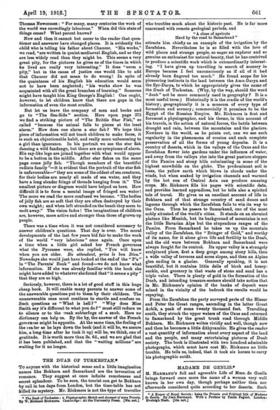THE DUAB OF TURKESTAN.* 'To anyone with the historical sense
and a little imagination names like Bokhara and Samarkand are the invocation of romance. They suggest at once infinite remoteness and secret splendour. To be sure, the tourist can get to Bokhara -by rail in ten days from London, but the time-table has not &Med its mystery. Mr. Rickmers is not the type of traveller
13.y W. Biekmer Eickmers. Cambridge : At the University Press. [30s. net.] Eveleigh Nash. [15a, net.]
who troubles much about the historic past. He is far more concerned with remote geological periods, and
"A close of apricots
Hard by the road to Samarkand"
attracts him chiefly as an example of the irrigation by the Zarafshan. Nevertheless he is so filled with the love of wild places and strange people, so eager an explorer and so genuine an enthusiast for natural beauty, that he has contrived to produce a scientific work which is extraordinarily interest- ing. "I have given up travelling in search of scenery in Europe because I feel unconsciously as if all of it had already been fingered too much." He found scope for his pioneering instincts in the land between the Amu-Darya and the Syr-Darya, to which he appropriately gives the name of the Duab of Turkestan. (Why, by the way, should the word " duab " not be more commonly used in geography ? It is a most useful term.) Historically it is the cradle of the world's history ; geographically it is a museum of every type of formation and scenery ; commercially it promises to be the Egypt of the Russian Empire. Mr. Rickmers is first and foremost a physiographer, and his theme, in this account of his travels, is the action of natural forces, the battle between drought and rain, between the mountains and the glaciers. Nowhere in the world, as he points out, can we see such regularity in the phenomena of erosion and such complete preservation of all the forms of young deposits. It is a country of deserts, which in the valleys of the Oxus and the Zarafshan flower into gardens under the influence of water, and away from the valleys rise into the great pasture steppes of the Pamirs and stony hills culminating in some of the highest snowfields on the globe. The predominant soil is loess, the yellow earth which blows in clouds under the winds, but when soaked by irrigation channels and warmed by the hot sun of Central Asia can produce amazing crops. Mr. Rickmers fills his pages with scientific data, and provides learned appendices, but he tells also a spirited tale of travel. He gives us an excellent account of life in Bokhara and of that strange country of sand dunes and lagoons through which the Zarafshan fails to win its way to the Oxus. Then he passes to Samarkand, one of the most nobly situated of the world's cities. It stands on an elevated plateau like Munich, but its background of mountains is not the little Bavarian Alps but the stupendous ranges of the Pamirs. From Samarkand he takes us up the mountain valley of the Zarafshan, the "Bringer of Gold," and worthy of its name, for it alone gives life and fertility to the Duab, and the old wars between Bokhara and Samarkand were always fought for its control. Its upper valley is a strangely sculptured place, first a deep gorge among stony hills, then a wide valley of terraces and scree slopes, and then an Alpine
glen ending in a glacier. Generally speaking, it is not beautiful, but it contains little dells of birch and honey- suckle, and greenery in that waste of stone and sand has a triple value. There is plenty of gold in the formation of the Duab, and intending treasure-seekers should take notice that in Mr. Rickmers's opinion if the banks of deposit were mined in the vicinity of the bedrock the results would be repaying.
From the Zarafshan the party surveyed parts of the Hissar and Peter the Great ranges, ascending in the latter Great Achik, a peak of some twenty thousand feet. Travelling south, they struck the upper waters of the Oxus and returned to Samarkand by the great trunk road through Middle Bokhara. Mr. Rickmers writes vividly and well, though now and then he becomes a little dithyrambic. He gives the reader a vast quantity of information about every aspect of the land and the people, and many entertaining pictures of Duals society. The book is illustrated with two hundred admirable photographs, which must have cost Mr. Rickmers no little trouble. He tells us, indeed, that it took six horses to carry his photographic outfit.










































 Previous page
Previous page